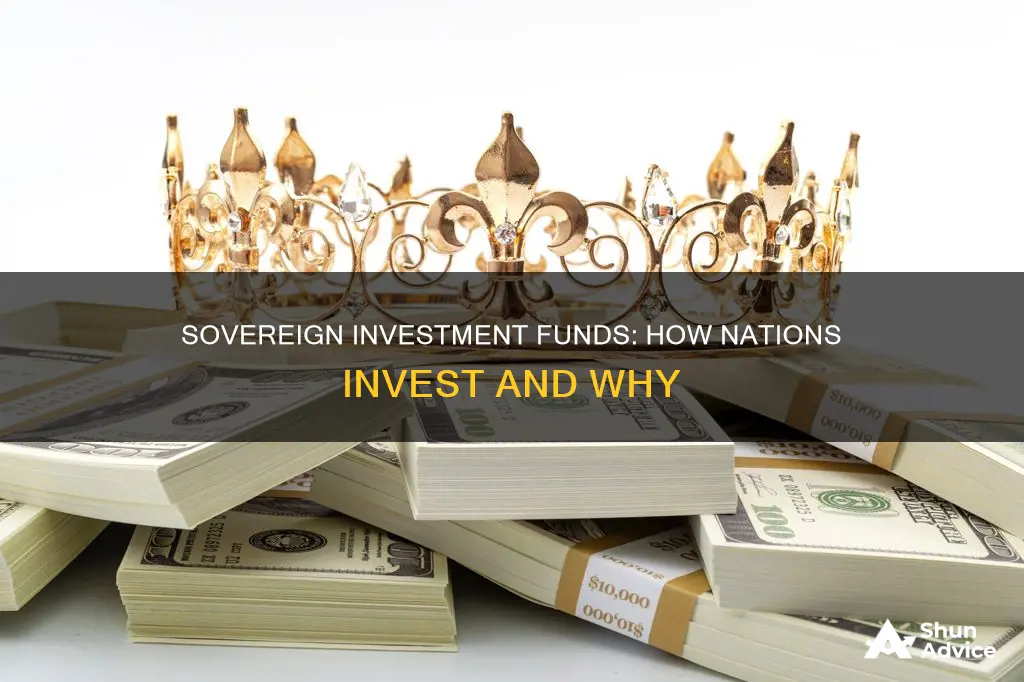
A sovereign wealth fund (SWF) is a state-owned investment fund that invests in real and financial assets such as stocks, bonds, real estate, and precious metals. They are owned by the general government, which includes both central government and sub-national governments, and invest in foreign financial assets for financial objectives. Sovereign wealth funds are usually funded by revenues from commodity exports or foreign exchange reserves held by the central bank. They can be held by a central bank or be the state savings that are invested by various entities for investment returns. SWFs have existed for over a century, with the first being set up in the mid-19th century to fund specific public services.
| Characteristics | Values |
|---|---|
| Type of fund | State-owned investment fund |
| Ownership | General government, including central government and sub-national governments |
| Investment type | Financial assets, stocks, bonds, real estate, precious metals, private equity funds, hedge funds |
| Funding sources | Commodity exports, foreign exchange reserves, surplus reserves, natural resource revenues, trade surpluses, bank reserves, foreign currency operations, privatisation revenues, governmental transfer payments |
| Purpose | Financial objectives, saving for future generations, stabilising government revenues, economic development |
| Risk management | Ranges from conservative to high-risk tolerance |
| Liquidity | May be a concern for some funds |
| Political influence | Potential for political influence, lack of transparency |
| Examples | Norway Government Pension Fund Global, China Investment Corporation, SAFE Investment Company, Abu Dhabi Investment Authority |
What You'll Learn
- Sovereign wealth funds (SWF) are state-owned investment funds
- SWFs invest in stocks, bonds, real estate, private equity and hedge funds
- SWFs are funded by revenues from commodity exports or foreign exchange reserves
- SWFs are created when governments have budgetary surpluses and little to no international debt
- SWFs are not homogeneous like central banks or public pension funds

Sovereign wealth funds (SWF) are state-owned investment funds
SWFs have three key characteristics: they are owned by the general government, they include investments in foreign financial assets, and they invest for financial objectives. These characteristics exclude public pension funds, which are ultimately owned by the underlying policyholders, and central bank reserve assets, which are not invested.
SWFs can have a variety of purposes, including savings or future generation funds, public benefit pension reserve funds, reserve investment funds, and strategic development funds. They can also target specific industries, such as emerging or distressed sectors. The amount of money in a SWF is usually substantial, and the acceptable investments included in each fund vary from fund to fund and country to country.
SWFs have existed for over a century, but their number has increased dramatically since 2000. The first SWFs were non-federal U.S. state funds established in the mid-19th century to fund specific public services, such as education. The first SWF established for a sovereign state was the Kuwait Investment Authority, a commodity SWF created in 1953 from oil revenues.
SWFs have become increasingly influential, and their growth is attracting close attention due to their potential impact on various asset markets. However, there are concerns about their lack of transparency and the potential for political influence.
Closed-End Funds: Worth Your Investment?
You may want to see also

SWFs invest in stocks, bonds, real estate, private equity and hedge funds
Sovereign Wealth Funds (SWFs) are state-owned investment funds that invest in a variety of asset classes, including stocks, bonds, real estate, private equity, and hedge funds. SWFs are typically funded by revenues from commodity exports, such as oil, or from foreign exchange reserves held by central banks.
SWFs provide an opportunity for governments to invest in stocks, which are shares of ownership in a company, offering higher yields than bonds but also greater risks. Stocks give shareholders a claim on the company's assets and voting rights at shareholder meetings.
Bonds are debt instruments where individuals lend money to a government or company at a fixed interest rate for a specified period. Bonds are used to finance projects and operations and are considered a relatively safe investment.
Real estate is another avenue for SWFs, either through direct purchases of commercial or residential properties or by investing in Real Estate Investment Trusts (REITs), which are similar to mutual funds.
Private equity funds are pooled investment vehicles where multiple investors contribute capital, and a private equity firm makes investments on their behalf, often taking a controlling interest in an operating company.
Hedge funds, typically only available to wealthy investors, aim to deliver returns beyond market performance but do not guarantee results and can be highly volatile.
SWFs have the flexibility to invest in a diverse range of assets, allowing them to balance their portfolios and manage risk according to their objectives and risk tolerances.
Target Date Index Funds: Invest or Avoid?
You may want to see also

SWFs are funded by revenues from commodity exports or foreign exchange reserves
Sovereign Wealth Funds (SWFs) are state-owned investment funds that invest in real and financial assets such as stocks, bonds, real estate, precious metals, private equity funds, and hedge funds. They are funded by revenues from commodity exports or foreign exchange reserves held by the central bank.
Commodity-rich countries often set up savings funds to save a portion of their resource wealth for the future. These funds are sometimes referred to as intergenerational savings funds as they have decades-long investment horizons. Oil, gas, and precious metal reserves are finite and will eventually run out. Therefore, countries with these resources set up SWFs to save a portion of their revenue for the future.
The funding for an SWF can come from a variety of sources, including surplus reserves from state-owned natural resource revenues, trade surpluses, bank reserves, foreign currency operations, money from privatizations, and governmental transfer payments. The acceptable investments included in each SWF vary from fund to fund and country to country.
Foreign currency reserve assets are powerful funds that may be used for specific governmental purposes and/or for helping to manage the trading power of a currency globally. These funds are usually of major economic and fiscal importance. They can also be used to quickly react to financial crises, as was the case during the 2007-2008 global financial crisis when SWFs were the first institutions to use sovereign capital to contain the financial damage.
The growth of SWFs has attracted close attention due to its potential impact on various asset markets. As of 2020, assets under management of SWFs amounted to $7.94 trillion.
A Simple Guide to Investing in Fidelity's Low-Cost Index Funds
You may want to see also

SWFs are created when governments have budgetary surpluses and little to no international debt
Sovereign Wealth Funds (SWFs) are state-owned investment funds that invest in real and financial assets such as stocks, bonds, real estate, precious metals, or alternative investments such as private equity funds or hedge funds. They are typically created when governments have budgetary surpluses and little to no international debt. This excess liquidity cannot always be held as money or channelled into immediate consumption, especially in countries that depend on raw material exports like oil, copper, or diamonds. In such cases, SWFs are created to manage the volatility of resource prices, the unpredictability of extraction, and the exhaustibility of resources.
SWFs are primarily commodity-based and are often established by oil-rich states. The funding for these funds can come from a variety of sources, including surplus reserves from state-owned natural resource revenues, trade surpluses, bank reserves, foreign currency operations, privatisation revenues, and governmental transfer payments.
The creation of SWFs allows governments to save a portion of their resource wealth for future generations. These savings funds are sometimes referred to as intergenerational savings funds and have long-term investment horizons. For example, oil, gas, and precious metal reserves are finite and will eventually run out. By investing in these funds, governments can ensure their country's prosperity for years to come.
SWFs can also be used to stabilise government revenues and counter the adverse effects of boom-bust cycles on government spending and the national economy. These stabilisation funds act as pools of capital that governments can draw on to smooth their budgets. They save some of the proceeds from large revenue influxes and pay out when commodity receipts fall below a specified amount.
In summary, SWFs are created when governments have budgetary surpluses and little to no international debt. This excess liquidity is then invested in a variety of assets to achieve financial objectives, providing economic benefits for the country and its citizens.
Mutual Funds and Bonds: A Beginner's Guide to Investing
You may want to see also

SWFs are not homogeneous like central banks or public pension funds
Sovereign Wealth Funds (SWFs) are not homogeneous like central banks or public pension funds. They are a diverse group of funds from every inhabited continent, with varied economic roles and mandates.
Firstly, SWFs are not homogeneous in their sources of funding and usage. They can be derived from a variety of sources, including surplus reserves from state-owned natural resource revenues, trade surpluses, bank reserves, foreign currency operations, privatisation proceeds, and government transfer payments. In terms of usage, SWFs usually have a targeted purpose, such as venture capital for the private sector, but this varies from fund to fund and country to country.
Secondly, SWFs are not homogeneous in their investment strategies. They invest in a range of asset classes, including stocks, bonds, real estate, private equity, and hedge funds. Some funds may prefer returns over liquidity, while others may prioritise liquidity over returns. This results in a spectrum of risk tolerances, from very conservative to a high tolerance for risk.
Thirdly, SWFs are not homogeneous in their organisational structure. While some are organised and managed at the national level, others are established at the regional level. For example, the Alaska Permanent Fund is managed by a board of trustees appointed by the Alaska State Legislature.
Fourthly, SWFs are not homogeneous in their investment objectives. They can be classified into several categories, including savings funds, stabilisation funds, and development/strategic funds. Savings funds, also known as future generation funds, invest for the long term and may allocate a significant portion of their portfolios to private markets. Stabilisation funds, also called rainy-day funds, provide capital during market shocks and tend to favour more liquid assets such as public stocks and bonds. Development or strategic funds contribute to the domestic economy, often through equity investments in domestic industries.
Finally, SWFs are not homogeneous in their geographical focus. While they invest globally, the distribution of their investments varies. For example, in recent years, developing countries have received the majority of public equity investments, while developed countries have attracted most of the investments in real estate.
Mutual Funds: A Smart Investment Strategy?
You may want to see also
Frequently asked questions
A sovereign wealth fund (SWF) is a state-owned investment fund that invests in real and financial assets such as stocks, bonds, real estate, and precious metals.
The funding for a sovereign wealth fund can come from a variety of sources, including surplus reserves from state-owned natural resource revenues, trade surpluses, and foreign currency operations.
Traditional classifications of sovereign wealth funds include savings or future generation funds, public benefit pension reserve funds, reserve investment funds, and strategic development sovereign wealth funds.
Sovereign wealth funds provide a benefit to a country's economy and its citizens. For example, they can be used to invest in domestic industries and infrastructure, creating economic growth and jobs.
Sovereign wealth funds are owned by the general government and include investments in foreign financial assets. In contrast, public pension funds are ultimately owned by the underlying policyholders, and central bank reserve assets are not invested.







